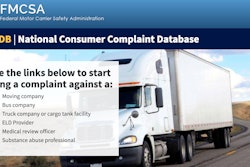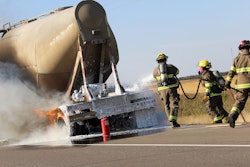Recent data from CarrierOK shows nearly 88,000 trucking companies have closed their doors in 2023, a steep increase compared to recent years. This is one of the many reasons why considerations for how to control and reduce costs are more pressing than ever. One area of consideration is a fleet’s roadside inspection results.
According to the Commercial Vehicle Safety Alliance (CVSA), there are 2.5 million to 3.5 million inspections of commercial motor vehicles each year in North America. Avoiding inspection violations can help your fleet maintain a good Compliance, Safety, Accountability (CSA) score that customers, insurance carriers, enforcement, and potential drivers consider when evaluating your company. Inspection fines can range from a few hundred to several thousand dollars, depending on factors including the severity of the violation, and whether it is a repeat offense.
[Related: Beating Roadcheck with preventive maintenance and driver buy-in]
Throughout my 35-year career as a driver and trucking business owner, I’ve been part of many roadside inspections and audits reviewing thousands of safety measurement scores during that time. Now as the trucking business segment consultant at Acuity Insurance, I help trucking businesses navigate the challenges of today’s trucking industry and how they can potentially obtain the highest return on investment (ROI) for their operation. When asked how these inspections affect their businesses, items such as insurance, customers, brokers, and driver recruitment and retention don’t always make a fleet’s list, but they are all heavily impacted. Putting it simply, safety should be one of the core elements of your trucking operation, not just one of your priorities. Anything less and you may be leaving profitability on the table and not realizing your full ROI.
To potentially improve your CSA results, it’s important to understand how CSA scores are determined. This knowledge can help you prevent violations before they happen.
How CSA scores are determined
Compliance, Safety, Accountability is the safety compliance and enforcement program of the Federal Motor Carrier Safety Administration (FMCSA), the organization that holds motor carriers and drivers accountable for their roles in safety.
With data collected through roadside inspections, crashes and investigations occurring within the past 24 months, CSA identifies large motor carriers to single driver owner-operators with safety problems and prioritizes them for interventions. These interventions usually take the form of warning letters or more-thorough investigations.
Violations are assigned to one of seven categories known as Behavior Analysis and Safety Improvement Categories (BASICs). With each category representing an important aspect of carrier safety performance, the BASICs include:
1. Unsafe Driving
2. Hours-of-Service (HOS) Compliance
3. Driver Fitness
4. Controlled Substances/Alcohol
5. Vehicle Maintenance
6. Hazardous Materials (HM) Compliance
7. Crash Indicator
Then each violation is weighed on its severity and how recently it occurred. Finally, CSA scores are evaluated in relation to other fleets.
6 ways to prepare for better roadside inspections
While several strategies and tactics can prepare fleets for better roadside inspections, these six will help get you off to a great start:
1. Comply with traffic regulations. While this may be obvious ensuring your drivers follow the posted speed limits, obey traffic signs, wear seat belts and avoid distracted driving is key to minimizing inspections. Ongoing driver training, driver incentive programs that reward clean driving records, and driver monitoring systems can help promote a culture of safety throughout your organization and help to minimize CSA violations.
2. Empower your people to be successful. Training your drivers, maintenance technicians, dispatch, and other support personnel drivers is one of the most important pieces to successful roadside inspections. Ensure your drivers know relevant regulations they may be asked about during an inspection. Regular driver training can help ensure that drivers are doing their part to comply with DOT regulations like HOS regulations, Commercial Driver’s License (CDL) requirements, vehicle weight limits and more.
3. Develop clear documentation processes. Registration, IFTA, IRP, insurance, driver’s licenses, medical cards, truck trailer maintenance records, annual vehicle inspections and other documentation must be accessible and kept current. If special circumstances are being used, such as leased vehicles, make sure your drivers understand the circumstances and are prepared to explain them to enforcement officers. One way to maintain that documentation is with a binder system. Keep all documentation up to date in a truck trailer binder and be prepared to explain it to law enforcement officers. If law enforcement cannot understand what is going on they may be more likely to write a citation.
4. Regularly inspect your fleet. Some owners operate under the assumption that it is their drivers’ responsibility to identify any issues with machinery and get those issues taken care of. In my opinion, this is not the right way to operate if you’re looking for maximum profitability. Your employees do not have your same level of financial interest in your equipment as you do. Take the time to walk your line of equipment weekly and look for problems or opportunities for improvement. Your employees are an important part of maintaining equipment but should not be expected to do the work to identify issues alone. I recommend taking a trust but verify approach. Empower them to know what to look for through training but verify that they’re doing their part to take care of the fleet. Teach mechanics and drivers how to fill out proper driver vehicle inspection reports (DVIRs). You can use the CVSA handbook as a great training guide. Then check whether pre and post inspections are being done correctly. Follow that up with a verification that your maintenance technicians can handle any identified safety defects and return trucks back to safe operations.
5. Study and understand your fleets historical numbers. Get to the bottom of the who, what, and where, and why behind your fleet’s CSA violations. I have unfortunately seen millions spent by some fleets before determining the root causes of poor CSA scores. It is more than just understanding the history, or assigning blame, the financial opportunity lies in developing an improvement path forward. Put another way, if you’re good at assigning blame, but poor at identifying opportunities and executing them on a path forward, your fleet may end up in the same place year after year. Identify issues, then create a plan to improve.
6. Use tools to identify areas of improvement. If you don’t already know your CSA score, you can obtain it from the DOT website. When you enter your USDOT number and PIN into the SMS login page, you will be able to locate your score. If you don’t have a PIN, you can request one from USDOT. There you can also identify which truck, trailer or driver had an interaction to help track and identify trends. Another great tool to utilize is the Carrier Compliance Questionnaire (CCQ) form. It is an internal document that a fleet can go through to help verify they are operating legally and to set goals if opportunities are identified.
Better roadside inspections require some planning and forethought, but the potential benefits — more manageable insurance premiums, better CSA scores, and improved customer retention — are worth the effort.











